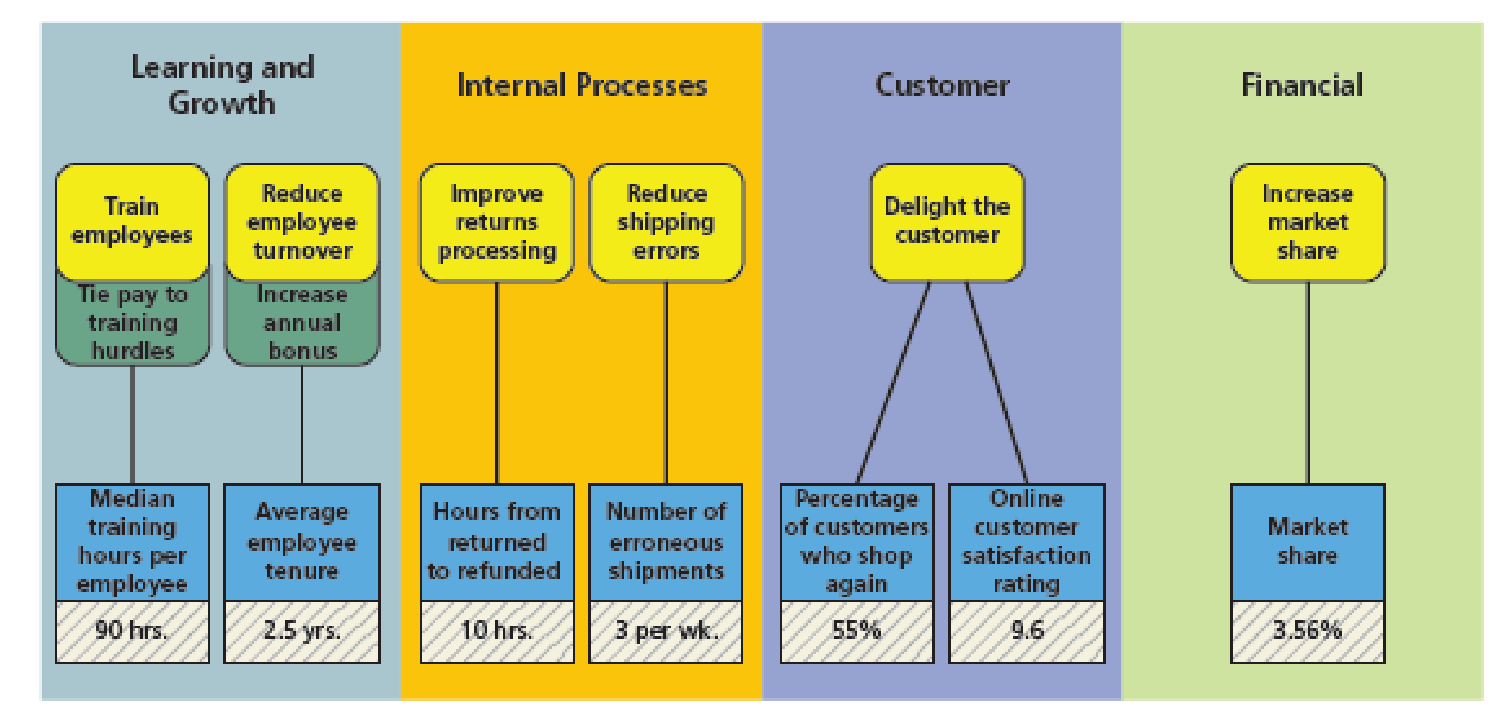

Instructions
1. Based on the balanced scorecard and the following descriptions of the predicted relationships between strategic objectives, draw the scorecard’s strategy map.
a. Training employees effectively and reducing employee turnover can both be expected to improve returns processing and reduce shipping errors.
b. Both improving returns processing and reducing shipping errors can be expected to delight the customer.
c. Delighting the customer can be expected to increase market share.
2. Based on the balanced scorecard and the following descriptions of the predicted relationships between performance metrics, draw the scorecard’s measure map.
a. Median training hours per employee and average employee tenure will both influence hours from returned to refunded and number of erroneous shipments.
b. Both hours from returned to refunded and number of erroneous shipments will affect percentage of customers who shop again and online customer satisfaction rating.
c. Both percentage of customers who shop again and online customer satisfaction rating will influence the company’s market share.
3. Label each element of the balanced scorecard.
Trending nowThis is a popular solution!

Chapter 28 Solutions
Financial And Managerial Accounting
- I need this question answer general Accountingarrow_forwardGeneral Accountingarrow_forwardPress Printing uses process costing. Department A had 3,700 units in beginning work in process (60% complete), added 8,200 units, and had 2,900 units in ending work in process (40% complete). If total processing costs were $89,000, Give the cost per equivalent unit. a) $10.00 b) $9.50 c) $8.76 d) $9.23 Answer this questionarrow_forward
 Managerial AccountingAccountingISBN:9781337912020Author:Carl Warren, Ph.d. Cma William B. TaylerPublisher:South-Western College Pub
Managerial AccountingAccountingISBN:9781337912020Author:Carl Warren, Ph.d. Cma William B. TaylerPublisher:South-Western College Pub Financial And Managerial AccountingAccountingISBN:9781337902663Author:WARREN, Carl S.Publisher:Cengage Learning,
Financial And Managerial AccountingAccountingISBN:9781337902663Author:WARREN, Carl S.Publisher:Cengage Learning, Cornerstones of Cost Management (Cornerstones Ser...AccountingISBN:9781305970663Author:Don R. Hansen, Maryanne M. MowenPublisher:Cengage Learning
Cornerstones of Cost Management (Cornerstones Ser...AccountingISBN:9781305970663Author:Don R. Hansen, Maryanne M. MowenPublisher:Cengage Learning Managerial Accounting: The Cornerstone of Busines...AccountingISBN:9781337115773Author:Maryanne M. Mowen, Don R. Hansen, Dan L. HeitgerPublisher:Cengage LearningPrinciples of Accounting Volume 2AccountingISBN:9781947172609Author:OpenStaxPublisher:OpenStax College
Managerial Accounting: The Cornerstone of Busines...AccountingISBN:9781337115773Author:Maryanne M. Mowen, Don R. Hansen, Dan L. HeitgerPublisher:Cengage LearningPrinciples of Accounting Volume 2AccountingISBN:9781947172609Author:OpenStaxPublisher:OpenStax College




